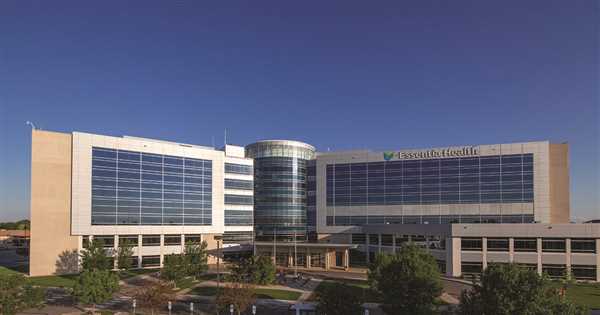Essentia Health-Fargo did not necessarily have a specific problem that led it to implement tele-stroke technology. Rather, the implementation stemmed from a desire to be proactive in delivering the best care possible.
A PROACTIVE MOVE
"Per AHA/ASA Stroke Care Guidelines, tele-stroke implementation is effective in triaging patients for IV thrombolytics and endovascular therapy," said Chelsey Kuznia, RN, SCRN, stroke program manager at Essentia Health-Fargo, DNV Certified Comprehensive Stroke Center.
"This technology is meant to provide timely access to expert stroke doctors to determine a plan of care for suspected or diagnosed stroke patients," she explained. "Much of Essentia’s service area includes rural communities that may not have access to a stroke expert. Tele-stroke allows us to offer that access almost immediately, even in rural areas."
PROPOSAL
Tele-stroke technology offered the chance for expert stroke care 24/7 across Essentia's service area, including the rural areas. With a simple phone call, the on-site provider can connect with the teleneurologist to discuss or perform a video assessment of the patient to determine treatment options, further imagining needed or other recommendations.
MARKETPLACE
There are many vendors of telemedicine technology and services on the health IT market today. Healthcare IT News published a special report highlighting many of these vendors with detailed descriptions of their products. Click here to read the special report.
MEETING THE CHALLENGE
Tele-stroke technology is used to improve timely access to an expert stroke provider. It is available to both emergency department and inpatient staff for use during a stroke alert.
"The process begins with the initiation of a stroke alert," Kuznia said. "If a patient is within the window for IV thrombolytics (less than 4.5 hours from last known well or LKW), a call is made to notify the teleneurologist that a consultation is needed.
"Once the discussion or video connection has been completed and recommendations made, the on-site provider will place orders and continue caring for the patient."
Chelsey Kuznia, RN, SCRN, Essentia Health-Fargo
"Essentia uses a tiered stroke alert process – a Level 1 or 2 stroke alert for a patient with LKW of 4.5-24 hours and a Level 3 stroke alert for a patient with LKW of greater than 24 hours or whose symptoms have resolved," she explained. "Once the call has been received, the teleneurologist discusses the patient’s case via phone with the on-site provider."
They decide if a video assessment to perform the NIHSS is needed for determining the plan of care. Video connections are primarily completed only for patients who are being considered for IV thrombolytics, or Level 1 stroke patients.
"Once the discussion or video connection has been completed and recommendations made, the on-site provider will place orders and continue caring for the patient," Kuznia noted. "Then, depending on the facility capabilities, a consult is placed for the on-site stroke team provider to see the patient, or a transfer of the patient to a higher level of care is initiated. The teleneurologist also documents the events that took place during the call."
RESULTS
Kuznia said it is difficult to quantify the hard results achieved because the impact of this technology is experienced throughout all core metrics of stroke care. Tele-stroke technology has impacted therapeutic treatment plans and staff confidence in providing stroke care.
"If we look closer at the administration of an IV thrombolytic in the treatment of acute ischemic stroke patients, there are ways that tele-stroke technology could have an impact," Kuznia explained. "The first is the consideration of an IV thrombolytic. Unfortunately, this is difficult to measure since it does not involve a timeframe but involves discussion and assessment.
"The teleneurologist can perform the NIHSS via the video connection and review the inclusion/exclusion criteria for IV thrombolytic administration with the patient and/or family, if available," she continued. "A thrombolytic is often a medication decision that general emergency or hospital providers prefer to discuss with an expert stroke doctor before ordering for administration."
The second way that tele-stroke technology could affect IV thrombolytic administration would be the "door-to-needle" time.
"This measurable metric is impacted due to streamlined access to an expert stroke provider for consultation," Kuznia explained. "For example, in the 12 months prior to the implementation of tele-stroke technology, four of five patients received a thrombolytic within 60 minutes of arrival. In the 12 months after implementation, 21 of 21 patients received a thrombolytic within 60 minutes of arrival."
Based on the data, one could also imply that initiation of tele-stroke technology increased confidence in administration of IV thrombolytics, as evidenced by the increase in the number of stroke cases that received a thrombolytic, she added.
ADVICE FOR OTHERS
"For other healthcare provider organizations considering tele-stroke technology, begin talking with your frontline staff early and involve them in the preparation of including it in your stroke code protocol," Kuznia advised. "Consistent use, education and timely follow-up is essential for successful implementation of this technology."
Follow Bill's HIT coverage on LinkedIn: Bill Siwicki
Email him: [email protected]
Healthcare IT News is a HIMSS Media publication.
Source: Read Full Article

